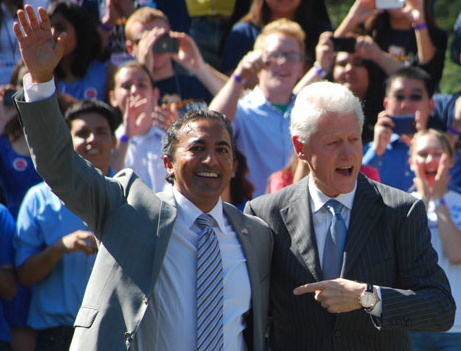5 Scenes from a Sequestered America
Q: How bad is it going to get out there? A: Not very.

Unless you've been living under a rock for a while now, you know the basic story about the automatic budget cuts that kicked in on March 1. Depending on who you listen to and how they figure things, as much as $85 billion in planned spending is being cut from a $3.6 trillion budget in fiscal year 2013 (which ends on September 30, 2013).
But of course, that's not quite right. It overstates the amount of cuts by 48 percent, or about $41 billion. As the Congressional Budget Office (CBO) noted in February, just $44 billion is being cut in actual 2013 spending: "additional reductions in outlays attributable to the cuts in 2013 funding will occur in later years."
The cuts are mainly coming from what's known as the discretionary budget, which covers stuff like defense spending and various sorts of programs whose spending totals are voted on every year. A small portion of the cuts will also come from mandatory spending, which covers entitlements such as Medicare. As the CBO does the math, of the $44 billion in cuts made this year, "Discretionary outlays will drop by $35 billion and mandatory spending will be reduced by $9 billion this year."

To hear the Obama adminstration tell it, the cuts are "Devastating" (that's the subject line in an email I just received from Stephanie Cutter of BarackObama.com. She continues:
Thanks to Republican obstructionism in Congress, the nation was forced into the sequester last Friday - a series of automatic and destructive budgets cuts that you and your neighbors are just beginning to feel.
I'm not sure it was Republican obstructionism alone that caused the sequester. A quick review of the matter shows that not only does the president bear responsibility for insisting on automatic cuts as part of the August 2011 deal from whence all this sprang, both parties are up to their arses in obstructionism. And when it comes to exaggerating the effects of the sequester, the Obama adminstration is doing its best to make the Pinocchio industry the top sector of the American economy. In just the past seven days, the "Fact Checker" at The Washington Post - no ardent enemy of Obama's general agenda - has awarded the president and his pals three separate "four Pinocchio" ratings (the worst possible) for wild claims about the sequester's effects on congressional janitors and public school teachers.
We're not quite yet a week into the sequester - "Devastating"! - but it's not too soon, is it, to ask how things are going?
Here are 5 scenes from a sequestered America. From a shuttered White House to a silenced Army band to the nation's airports to tinder-dry combustible cities to food programs aimed at poor kids and mothers, things are surprisingly…uneventful.
To read this as a single page, click here.
Next: Life in the Beggared White House…

1. No Oval Office Tours, But Plenty of Hand-Crafted Notecards.
From Reuters comes the harsh news:
"Due to staffing reductions resulting from sequestration, we regret to inform you that White House Tours will be cancelled effective Saturday, March 9, 2013, until further notice. Unfortunately, we will not be able to reschedule affected tours," the White House Visitors Office said in an email on Tuesday.
The good news? If you do get invited to the White House for a dinner, you'll get a really cool place care. There are no plans to trim the three White House employees who are employed as calligraphers and cost taxpayers more than a quarter of a million dollars a year in salary alone.
Next: The Band Won't Play On…

2. Military Band "Pershing's Own" Cancels Concerts.
The Washington Post reports that
The famed U.S. Army band, "Pershing's Own," canceled its anniversary concert last weekend at the Strathmore Music Center in North Bethesda and is preparing to cancel other concerts as a result of federal budget uncertainties.
According to the paper, "Cutting hall rentals and other expenses would yield about $100,000 in savings." The Post also notes that, all told, the various branches of the military maintains about 148 bands with a combined annual budget of "about $388 million a year."
On the other hand, "essential" military operations - including personnel costs - are exempted from the sequester. Apparently, so is the dysfunctional and generally unnecessary F-35 fighter jet program, which will cost $1.5 trillion over the course of its sorry life.
Next: Airport Wait Times - or Maybe Just DHS Exaggerations - Are Getting Longer….

3. TSA Lines Are Getting Longer - But Only in the Future.
CBS News reports thus:
On Monday, Homeland Security Secretary Janet Napolitano told reporters that major airports had seen lines ballooning to 150-200 percent their normal size. The Transportation Security Administration later clarified that it was not yet seeing longer-than-normal checkpoint lines.
Got that? Lines are getting longer except where they're not. At least not yet. But you just wait and see.
Meanwhile, the Wall Street Journal talked to honchos at various big airports. "We haven't seen any delays out of the ordinary," said a person from San Francisco's international airport (SFO). DHS officials had said that there were major delays at Miami's airport and at New York's JFK over the weekend, though "a JFK airport spokesman said he hadn't received any reports of unusually long lines since Friday," when the sequester began. And neither the Miami nor JFK spokesmen reported any trouble this Monday. It all sounds, what's the word? - "Devastating!"
Next: Is Sacremento Burning…?

4. Congressman Lights Own Pants on Fire.
In the run-up to the sequester, Rep. Ami Bera (D-Calif.) announced that if sequester cuts to federal fire-fighting grants came to pass, his Sacremento constituents would be put at risk. "People are going to be unsafe, homes are going to burn. We have to act." To underscore his point, Bera said that his district alone would lose $1.5 million from a particular federal grant program, or the equivalent of "one engine company." You could practically smell the flesh burning.
While it's not clear yet whether those cuts either have happened or will ever happen, the fact-checking outfit Politifact dug into Bera's numbers deep enough to learn that in the worst case scenario, the amount of reduced funding in question would amount to just $300,000 - or about one-fifth the amount Bera claimed. Even more damning for the congressman, Politifact calculated "the sequester could hold back two-tenths of 1 percent of the [Sacramento fire] department's entire budget."
So if you smell smoke around Rep. Ami Bera, relax. It's just his pants that are on fire.
Next: Welcome to the Sequester's Hunger Games!…

5. Will Little Kids and Their Moms Starve?
Writing at The Daily Beast, Joel Berg blasts the "many members of Congress who label themselves as 'pro-life,' [yet who] would remove 600,000 mothers and infants from WIC." WIC is short for "Special Supplemental Nutrition Program for Women, Infants, and Children," which, according to the government, "serves low-income pregnant, postpartum and breastfeeding women, and infants and children up to age 5 who are at nutrition risk."
The exact provenance and reliability of Berg's 600,000 number isn't clear from his story (it appears to come from the White House), but it seems heartless indeed to screw poor moms and their kids. According to an Office of Management and Budget (OMB) list generated last year, WIC is indeed on the list of programs subject to the sequester. Out of a total of $6.6 billion in funding for the program, $543 million is on the chopping block (go to page 28 of the OMB list). Does that mean that hungry mothers and children will have food snatched from their mouths? As with so much of the sequester, that's far from clear, either in the short-run or the long-run. WIC is available to people in households who live at or below 185 percent of the official poverty line. Using 2013 numbers, that comes to a household income of up to $21,000 for one person, $29,000 for two people, $36,000 for three, and $44,000 for four people. Those are not income figures we normally associate with people living on the edge of starvation or malnutrition.
Such calculations hardly mean that life is easy for the poor - even as they suggest that many programs associated with poverty serve many folks who are not particularly poor. In a 2009 study, Douglas J. Besharov of the American Enterprise Institute and Douglas M. Call of the University of Maryland, found that in 2006, 18 percent of WIC recipients lived in households whose incomes exceeded 185 percent of the poverty line. In fact, 5 percent of recipients lived in households with incomes of 300 percent over the poverty line. Besharov and Call write that, using 2006 data, "between 74 and 81 percent of all American infants would be WIC eligible (emphasis in original).
Is it realistic to assume that four out of five kinds under the age of five live in families that need WIC? Certainly not.
And it's just as likely that even programs designed for the poor - just like White House tours and Army marching bands and federal grants to fire departments - can be trimmed without turning America into a savage nation of all against all.


Show Comments (113)